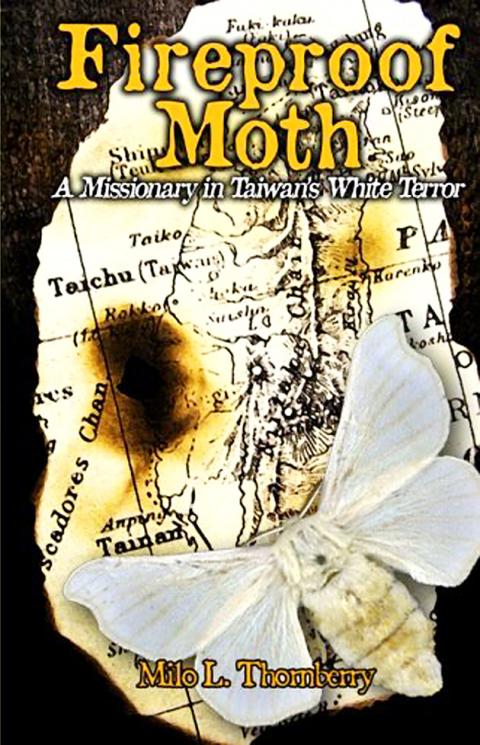Fireproof Moth is an autobiographical account of a Methodist missionary’s stay in Taiwan in the late 1960s, but it reads like a thriller.
Author Milo L. Thornberry first describes his personal journey to becoming a minister in the mid 1950s. In 1965, the Methodist Church decided to send Thornberry and his wife Judith to Taiwan, and the couple went through preparatory sessions at Drew University and Stony Point Missionary Orientation Center north of New York. During this time he read some critical works such as George Kerr’s Formosa Betrayed and Mark Mancall’s Formosa Today.
Upon arrival in Taipei on New Year’s Eve 1966 the couple settled down, started language school, and gradually came to experience the suffocating hold that the Chinese Nationalist Party (KMT) regime of Chiang Kai-shek (蔣介石) had on society in Taiwan. They also got to know Peng Ming-min (彭明敏), a professor who was under house arrest at the time for publishing a document titled A Manifesto for Self-Salvation in 1964.

The couple started to help channel support from overseas to families of political prisoners, with the help of Peng’s two courageous students, Hsieh Tsung-min (謝聰敏) and Wei Ting-chao (魏廷朝). They also began producing mimeographed information sheets to inform visiting friends and colleagues overseas about the repressive political atmosphere in the country.
Together with other foreign friends in Taiwan they approached American and European reporters and supplied background information on developments in Taiwan. Fox Butterfield of the New York Times and Selig Harrison of the Washington Post were among the reporters they communicated with.
When in September 1968 Peng told the couple that he had received indications from the Investigation Bureau of the Ministry of Justice, one of the main secret police organizations at the time, that he might have an “accident,” a plan was devised to smuggle him out of Taiwan. After more than a year of preparation the plan became a reality, and on Jan. 3, 1970, Peng left Taiwan using a doctored Japanese passport and disguised as a Japanese musician.
He made it safely to Sweden, where he received political asylum. Eventually Peng made it to the US, where he became a senior research scholar and visiting professor at the University of Michigan.
Oddly, the KMT authorities never discovered the role played by Thornberry and his wife in Peng’s escape. They surmised that he had been helped by the CIA. The matter even came up in the February 1972 discussions between then-US national security adviser Henry Kissinger and president Richard Nixon with Chinese premier Zhou Enlai (周恩來). Zhou accused the Americans of aiding Peng in his escape, but Nixon responded with indignation: “We had nothing to do with it.”
However, Taiwan’s secret police agencies kept an ever tightening watch over Milo and Judith, and on March 2, 1971 — more than a year after Peng’s escape — they were arrested and expelled from Taiwan. Selig Harrison visited them in their home while they were under house arrest and wrote a front-page article about it in the Washington Post (“Taiwan expels US missionary,” March 4, 1971).
It wasn’t until December 2003, at a reunion of human rights and democracy activists organized by the Taiwan Foundation for Democracy, that Milo and Judith — as well as the Japanese counterparts who also played a crucial role — disclosed their involvement in Peng’s escape.
The book reads like a spy thriller and fills a key void in the written history of Taiwan’s very recent transition to democracy. It is highly recommended.

Seven hundred job applications. One interview. Marco Mascaro arrived in Taiwan last year with a PhD in engineering physics and years of experience at a European research center. He thought his Gold Card would guarantee him a foothold in Taiwan’s job market. “It’s marketed as if Taiwan really needs you,” the 33-year-old Italian says. “The reality is that companies here don’t really need us.” The Employment Gold Card was designed to fix Taiwan’s labor shortage by offering foreign professionals a combined resident visa and open work permit valid for three years. But for many, like Mascaro, the welcome mat ends at the door. A

Last week gave us the droll little comedy of People’s Republic of China’s (PRC) consul general in Osaka posting a threat on X in response to Japanese Prime Minister Sanae Takaichi saying to the Diet that a Chinese attack on Taiwan may be an “existential threat” to Japan. That would allow Japanese Self Defence Forces to respond militarily. The PRC representative then said that if a “filthy neck sticks itself in uninvited, we will cut it off without a moment’s hesitation. Are you prepared for that?” This was widely, and probably deliberately, construed as a threat to behead Takaichi, though it

Nov. 17 to Nov. 23 When Kanori Ino surveyed Taipei’s Indigenous settlements in 1896, he found a culture that was fading. Although there was still a “clear line of distinction” between the Ketagalan people and the neighboring Han settlers that had been arriving over the previous 200 years, the former had largely adopted the customs and language of the latter. “Fortunately, some elders still remember their past customs and language. But if we do not hurry and record them now, future researchers will have nothing left but to weep amid the ruins of Indigenous settlements,” he wrote in the Journal of

If China attacks, will Taiwanese be willing to fight? Analysts of certain types obsess over questions like this, especially military analysts and those with an ax to grind as to whether Taiwan is worth defending, or should be cut loose to appease Beijing. Fellow columnist Michael Turton in “Notes from Central Taiwan: Willing to fight for the homeland” (Nov. 6, page 12) provides a superb analysis of this topic, how it is used and manipulated to political ends and what the underlying data shows. The problem is that most analysis is centered around polling data, which as Turton observes, “many of these